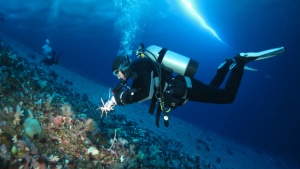Sea spiders, or pycnogonids, are a group of spider-like invertebrates found in marine habitats globally. Most species are smaller than a fingernail, but some Antarctic species have leg spans (tip of one leg to the tip of the opposite leg) of more than a foot. These animals are a famous example of “polar gigantism,” a phenomenon where certain organisms in polar regions, such as the Arctic and Antarctic, grow to much larger sizes than their relatives in warmer climates.
“In most sea spiders, the male parent takes care of the babies by carrying them around while they develop,” UH Mānoa School of Life Sciences Professor and lead researcher Amy Moran said. “What’s weird is that despite descriptions and research going back over 140 years, no one had ever seen the giant Antarctic sea spiders brooding their young or knew anything about their development.”
Moran’s lab has studied polar gigantism for more than a decade. In October 2021, during a field research expedition to Antarctica, the team, including Moran and School of Life Sciences Ph.D. students Aaron Toh and Graham Lobert, made a groundbreaking discovery. Diving under the ice, they hand-collected groups of giant sea spiders that appeared to be mating and transported them to tanks for observation.

Moran on a research dive, picking up a large sea spider (Image credit: R. Robbins)
To their amazement, two different mating groups produced thousands of tiny eggs. Instead of carrying the babies until they hatched, as in most species of sea spiders, one parent (likely the father) spent two days attaching the eggs to the rocky bottom where they developed for several months before hatching as tiny larvae. The researchers findings were published in Ecology in February 2024.
“We were so lucky to be able to see this,” Toh said. “The opportunity to work directly with these amazing animals in Antarctica meant we could learn things no one had ever even guessed.”
Within weeks after laying, the eggs had been overgrown with microscopic algae, providing perfect camouflage.
“We could hardly see the eggs even when we knew they were there, which is probably why researchers had never seen this before,” Lobert said.
Breakthrough Research
Lloyd Peck, a renowned Antarctic biologist with the British Antarctic Survey who was not involved with the study said, “The general ecology and reproductive biology of Antarctic marine species remains overwhelmingly unknown, and we have data on only a handful of species, so papers like this one are of huge importance in shedding light on how animals function in one of the least studied parts of the world’s ocean.”
The UH Mānoa School of Life Sciences is housed in the College of Natural Sciences.

